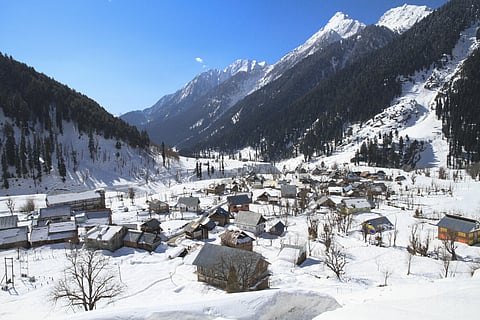
- Destinations
- Experiences
- Stay
- What's new
- Editor’s Picks
- Responsible Tourism
- CampaignsCampaigns
- Subscribe

The Kolahoi Glacier, also known as the "Hanging Glacier," is a breathtaking trekking destination in the Kashmir Valley. It sits at an altitude of around 15,420 feet and serves as the main source of the Lidder River. The glacier is surrounded by stunning alpine scenery. Trekking to Kolahoi Glacier offers a perfect blend of adventure, natural beauty, and cultural experiences, making it a must-visit for trekkers and nature enthusiasts. We have culled all the necessary details that a trekking enthusiast must be aware of before embarking on this trek, along with a short itinerary. Check out the details and plan your trip accordingly for the most effective visit.

The Kolahoi Glacier is a significant part of the Kashmir Valley, attracting explorers, trekkers, and mountaineers from around the world. It has historically been a vital source of water and livelihood for local communities. The glacier is located in the Anantnag district of Jammu and Kashmir, nestled in the Himalayas at the head of the Lidder Valley. It is surrounded by peaks, including the Kolahoi Peak, which stands at 17,798 feet. Rugged mountains, lush meadows, dense forests, and sparkling streams characterise the terrain. The glacier is part of the Kolahoi Massif and plays a significant role in the hydrology of the Lidder and Sind rivers.

The trek to Kolahoi Glacier takes you through diverse ecosystems. Lower altitudes feature dense coniferous forests; higher up, you'll find alpine meadows with vibrant wildflowers. The fauna includes the Himalayan brown bear, musk deer, snow leopard, Himalayan monal, golden eagle, and various species of pheasants.

The Kolahoi Glacier trek offers major attractions and highlights, including the breathtaking views of the hanging glacier and surrounding peaks at Kolahoi Glacier. You can also enjoy the serene backdrop and trout fishing opportunities along the pristine Lidder River, explore the picturesque meadows and pastoral beauty of Aru Valley, camp at the beautiful meadow of Sekiwas, and relax at the scenic campsite of Satlanjan, known for its stunning views and tranquil environment.
The Kolahoi Glacier trek is a once-in-a-lifetime adventure, revered locally as the "Goddess of Light" for being a perennial water source powering major rivers like Jhelum and Lidder. Unfortunately, climate change has diminished this five-kilometre-hanging glacier over the years. The five-day trek, capturing the unique charm of Kashmir, begins at Aru, a gateway to over 25 alpine lakes and numerous high-altitude ponds. The trail meanders through lush meadows, along the banks of the Lidder River, and across expansive Himalayan valleys, surrounded by acres of coniferous forests. The journey culminates at the magnificent Kolahoi Glacier, epitomising the sentiment that the journey is as important as the destination.
The trek to Kolahoi Glacier typically spans over 4-5 days, beginning from the village of Aru. It is graded as a moderate to challenging trek, requiring good physical fitness and preparation. The journey takes trekkers through diverse landscapes, from dense forests and verdant meadows to high-altitude glaciers and snow-capped peaks.
Day 1: Arrival in Aru
Altitude: 7,884 feet
Highlights: Upon arriving in Aru, trekkers are greeted by the delightful charm of this picturesque village. Surrounded by lush meadows and stunning landscapes, Aru provides an ideal setting to acclimate. You can spend the day exploring the village, engaging with the amiable locals, and relishing the surroundings. The evening can be devoted to preparing for the upcoming trek, making sure all gear is ready, and spirits are high.
Day 2: Aru to Lidderwat
Distance: 11 km
Altitude: 10,000 feet
Highlights: The trek begins with a path that winds through dense coniferous forests, running alongside the Lidder River. Along the way, you will encounter wildflowers and occasional wildlife before reaching the lovely campsite at Lidderwat. Here, you can set up camp, enjoy a meal, and rest under the stars.
Day 3: Lidderwat to Satlanjan
Distance: 9 km
Altitude: 11,482 feet
Highlights: Leaving Lidderwat, the trail ascends through colourful alpine meadows with stunning views of snow-capped peaks. The campsite at Satlanjan offers a perfect vantage point for appreciating the Himalayan landscape. You can relax, take photos, and prepare for the next day's ascent to the glacier.
Day 4: Satlanjan to Kolahoi Glacier and back to Lidderwat
Distance: 12 km (round trip)
Altitude: 15,420 feet
Highlights: On this day, you will reach the majestic Kolahoi Glacier, the highlight of the trek. The path becomes more challenging as trekkers navigate rocky terrain and glacial moraine. Upon reaching the glacier, you get rewarded with breathtaking views. After exploring and photographing the glacier, retrace your steps back to Lidderwat for an overnight stay.
Day 5: Lidderwat to Aru and Departure
Distance: 11 km
Altitude: 7,884 feet
Highlights: On the final day of the trek, descend back to Aru, providing an opportunity to savour the valley's beauty one last time. Once in Aru, the trek concludes, and you can either prepare for departure or spend an extra day in the village to relax.
To reach Pahalgam and Aru Valley, the only option is by road. From Srinagar, travellers can take a shared taxi to Anantnag (also known as Islamabad), a large town southeast of Srinagar. The two-hour trip costs INR 100. From Anantnag, they can switch to another shared taxi to Pahalgam. The one-and-a-half-hour trip costsINR 80 . While some people choose to stay in Pahalgam, it is recommended to take another shared taxi to the village of Aru, located at the end of the motorable road. Shared taxis from Pahalgam to Aru Village depart when full from the central taxi stand, and the 30-minute trip costs INR 30. Alternatively, a private taxi can be hired from Srinagar to Pahalgam and Aru Valley.
